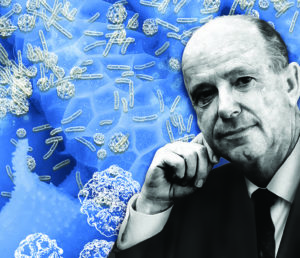2022 marks the JGI’s 25th anniversary. Over the next few months, we’ll be revisiting a number of notable achievements that showcase our collaborations and capabilities to enable great science that will help solve energy and environmental challenges.

The Hungate1000 is named for Robert Hungate, who invented the method of cultivating strictly anaerobic bacteria. (Photo: Special Collections, University of California Library, Davis; Composite: JGI/Berkeley Lab)
Methane emissions are a massive factor driving climate change. According to the Environmental Protection Agency, methane gas warms the atmosphere as much as 25 times more quickly than even carbon dioxide. The EPA attributes one-fifth of all methane emissions to livestock and roughly one-third of human-created methane emissions actually come from livestock — specifically, from the methane-making microbes within their rumen.
There is another climate-minded reason for studying rumen: Livestock live off plant matter, and their rumen are highly capable of breaking down potential biomass sources in ways we are only just beginning to understand. A better understanding of rumen and the microbes that live there can drive solutions into stemming methane-emissions as well as efficient engineering of biofuels.
Since 2010, the JGI has partnered with researchers around the world to map out genomes of rumen microbes. In 2018, through a JGI Community Science Program proposal that started six years earlier, researchers put together what they called the Hungate1000, a catalog of 410 rumen microbe genomes. The project relied upon resources from laboratories around the world, encompassing 54 researchers from 14 organizations across nine countries.
To date it is the single largest effort to provide a cataloged and curated culture and genome sequence resource of rumen microorganisms.
Thanks to the breadth of this study, researchers around the world are continuing to build on Hungate 1000 genomes and cultures to work toward a variety of methane-mitigation goals. One aim is identifying chemical compounds that could inhibit microbial methane production. Another effort is in using microbial understanding to formulate a vaccine for livestock, to the same effect. Yet another approach is using the Hungate1000 collection to identify microbial markers that would allow farmers to screen livestock, and breed low-methane producing animals.
The Hungate1000 collection has also opened up research offshoots in totally different areas, beyond the project’s initial scope. Sequencing and culturing this vast collection of rumen microbes gave researchers access to a collection of novel enzymes — many of which contained interesting properties in themselves. For example, a few organisms originally sequenced in the Hungate1000 collection harbor enzymes that could be useful for transcriptomic engineering.
As one example, researchers who worked on the Hungate1000 project were able to provide colleagues at the Salk Institute with genomic DNA samples from Ruminococcus flavefaciens (XPD3002). With that sample, the Salk Institute team was able to engineer and test a ribonuclease capable of knocking down human RNA the way that CRISPR-Cas9 systems snip DNA. This could eventually lead to applications allowing for genome editing in RNA, rather than DNA alone.
“It has become a tool widely used,” Leahy told JGI recently when we caught up with her. “… We are very happy that the Hungate1000 helped spark some innovation in this space. To us, rumen microbes are awesome and this is just another example why.”
RELATED LINKS